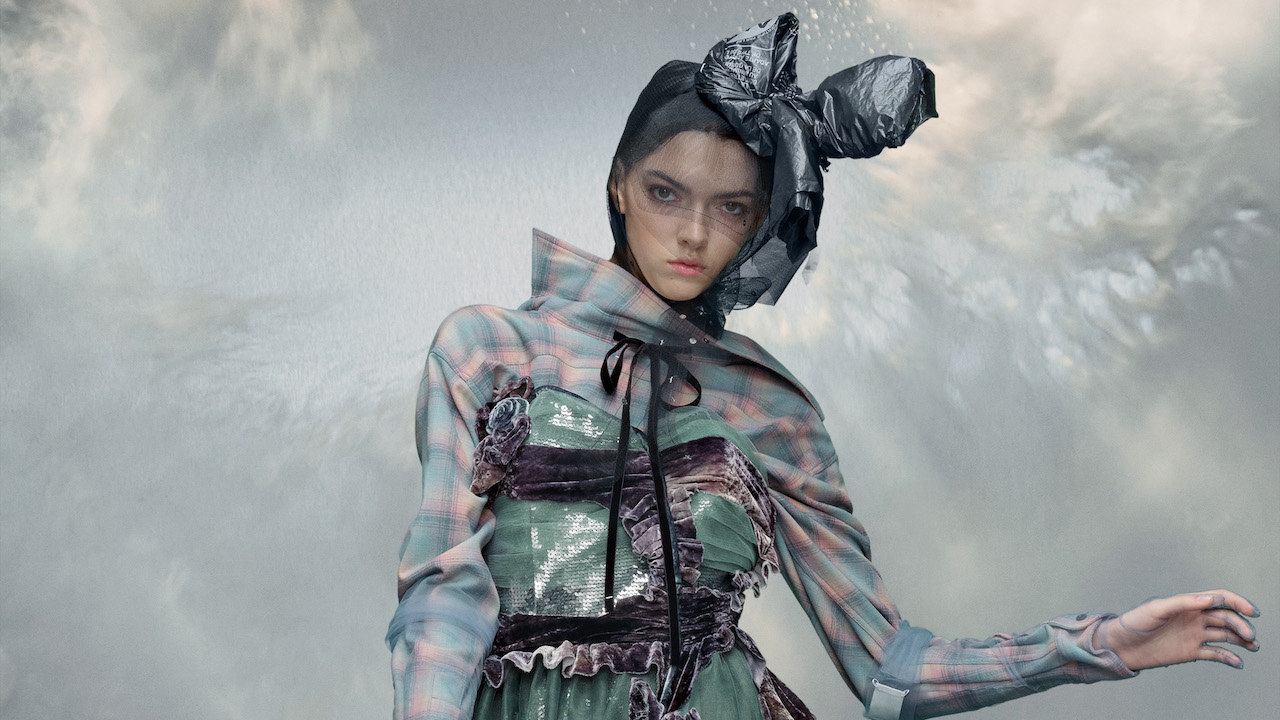Luxury Briefing: Why luxury x American heritage brand collaborations are suddenly everywhere
This week, a look at Maison Margiela x Pendleton, Peter Do x Banana Republic, Dickies x Willy Chavarria, and the other new collaborations between high-end and American heritage brands. Plus, an analyst’s take on what’s next for Tapestry. Scroll down to use Glossy+ Comments, giving the Glossy+ community the opportunity to join discussions around industry topics.
It’s been a while since 160-year-old, Oregon-based Pendleton had a viral moment — 25 years, to be exact. In the late ’90s, the actor Jeff Bridges wore the brand’s Westerley sweater to the set of “The Big Lebowski,” after choosing his character’s now-signature outfit from his own closet.
“Bless Jeff Bridges,” said Peter Bishop, Pendleton’s evp of merchandising and design, and a sixth-generation member of the family-owned business. He said the sweater, originally designed in 1972, has been a “great seller” ever since. “That movie has a real following, and it’s hard to create that lightning strike. We always ask ourselves, ‘What’s going to be the next ‘Big Lebowski’ sweater?’”
Taking part in more official product collaborations has been one way Pendleton has aimed to attract buzz. Most recently, it collaborated with Maison Margiela on a runway collection that debuted on the French fashion house’s fall 2023 runway. The styles were released on August 2 via Maison Margiela’s stores and e-commerce site. Prices range from $1,200 for a pair of trousers to $2,700 for a fringed cardigan.
In its press release for the line, Maison Margiela plays up Pendleton’s “authenticity” and its “classic” styles. It notes that Pendleton produces its pieces in two of the four remaining wool mills in the U.S. – the brand owns both. And it describes the collection as a “creative dialogue” that “fuses the plaids of the American heritage weaver with the haute couture grammar of Creative Director John Galliano.”
Of course, this is far from the first time that a higher-end fashion house has linked with a history-rich American brand. Rick Owens has collaborated with Champion since 2019 and Converse since 2021. Or, think: Vetements x Levi’s for fall 2017. But the trend has recently gained steam.
The week alone, Peter Do announced an upcoming collaboration with Gap, Inc.’s Banana Republic. Plus, Willy Chavarria debuted a line with Dickies. At a comparatively more accessible tier, CDG by Comme des Garcons debuted a line with The North Face, and contemporary brand Ganni came out with a New Balance sneaker. And let’s not forget Palace x McDonald’s, announced last week.
At a time when mid-level brands are feeling squeezed and luxury brands are struggling to maintain growth, these new collaborations offer both parties the opportunity to play to a new set of consumer habits. Top luxury shoppers have proven extraordinarily resilient to economic impacts, while time-tested heritage brands portray quality, exude values and spark nostalgia. Oh, and they often cost less. What’s more, providing newness via a novel partnership is a proven strategy.
“We have a steady stream of brands coming to us because we’re a heritage brand,” Bishop said. “But our internal team has great insight into the marketplace and is passionate about and protective of the Pendleton brand. So, the first question they always ask is, ‘Why would we do this?’”
According to Bishop, Maison Margiela made sense as a collaborator primarily because it’s so different from the Pendleton brand. The creativity and “theatrics” it delivered through the collection and its corresponding runway show did not disappoint, he said.
To develop Maison Margiela x Pendleton, Heather Amorebieta, Pendleton’s head of product licenses and brand collaborations, worked with Margiela’s design team. Galliano chose three weaves from the Pendleton archives to include in designs ranging from hoodies to tulle skirts.
Bishop said the comments in response to the brand’s social posts featuring the collection have been mixed, with some followers’ saying they’re “blown away” or “excited,” and others clearly confused by the look.
“In the past, we’ve been criticized for staying in our lane too much; we haven’t strayed too far from our origins. But that’s been to our benefit,” Bishop said. “We have this history to work with, and our archives run deep. The challenge is keeping it [feeling] fresh, relevant and unexpected.”
On that note, 45-year-old Banana Republic is two years into a “transformational journey” centered on modernization and elevation, said Meena Anvary, its head of marketing. Playing into that is a newly announced collaborative collection with NYC-based designer Peter Do, set to launch in October.
“The intersection of our heritage and Peter’s unique design sensibility creates a fresh look for our customers,” said Anvary.
Reaching a new customer, shifting brand perceptions and creating more desire around the Banana Republic brand and its products are also among the goals, she said. And she mentioned Do’s engaged social media community, which should help support those efforts.
To describe the collection, Anvary focused on details synonymous with typical luxury brands, including the styles’ “impeccable” tailoring and craftsmanship, and their longevity based on the quality materials and timeless designs.
And on the other side of the spectrum is Willy Chavarria. The New York-based designer said he decided to collaborate with 101-year-old Dickies on a workwear collection, released Wednesday, to provide accessibility to his namesake fashion brand. Chavvaria described his 8-year-old label as a non-exclusive luxury brand. A T-shirt in his core collection sells for $265, while a co-branded Dickies jacket is $250.
Other drivers of the collab included Chanvarria’s own nostalgia, having loved Dickies while growing up, he said. The brands’ aligned values of inclusivity and authenticity were also a factor.
“I want people to feel the connection to the heritage and craftsmanship behind the collaboration and the rich history embedded within the designs,” he said. “Collaborations can be powerful in opening the door to new audiences.”
Pendleton knows that well. Its first significant fashion collaboration was with Opening Ceremony, starting in 2009. “It made people in the fashion industry look at us in a different light, and we looked at ourselves in a different light,” Bishop said. Realizing the opportunity to be creative and reach new audiences, Pendleton has been taking part in regular collaborations ever since. For example, in 2015, it teamed with Canada Goose, and it collaborated with Cole Haan last year. Two more Pendleton collaborations are set to launch before the end of 2023.
Collaborations are a marketing play and “very rarely a significant sales driver,” Bishop said. But it’s worth noting that the brand has increasingly earned shoppers in their 20s, building upon its core customer base of men and women in their 30s-50s. It’s been a years-long goal.
In 2011, Pendleton introduced the Portland Collection, a spinoff line of styles targeting younger, fashion-forward shoppers, in the vein of Carhartt’s Carhartt WIP. According to Bishop, it was a fun line to work on internally and attracted buzz. But, thanks to the styles’ incorporation of luxury materials, premium details and original fits, they were expensive, reportedly selling for $180-$850. As such, the line proved to be “commercially challenged” and was discontinued in 2014.
Today, Pendleton’s home business is its top revenue-producing category, with its wool blankets being the core driver. At No. 2 is its men’s and women’s tops, including outerwear, wool flannel shirts and sweaters. Its wholesale-direct-to-consumer split is 50-50, and its marketing mix is heavy on social media and print catalogs.
According to Bishop, the company saw an unexpected sales surge during the pandemic, thanks to new demand for its outdoor-inspired clothing and home products. However, sales have balanced out, while the company’s materials, labor and freight cost have “significantly” increased over the past two years, he said.
“We’re feeling price pressure,” he said. “There’s a limit to what our customers are willing to pay, and finding the right balance has been a challenge.”
‘A difficult sell to investors’: What Tapestry’s Q4 earnings say about the future of the company
Owner of Coach, Kate Spade and Stuart Weitzman owner, Tapestry, Inc. has been at the center of American fashion buzz since announcing its acquisition of Capri Holdings on August 10. On Thursday, it reported its fourth-quarter earnings, which, at a flat $1.62 billion, fell short of Wall Street’s expectations.
Immediately following the earnings update, Brian Yarbrough, consumer discretionary analyst for Edward Jones, shared with Glossy his thoughts on the big merger and what it means for the future of the six involved brands. Below are the highlights from the conversation, which have been lightly edited for clarity.
“We had a buy on Tapestry’s stock, but we downgraded it when they announced the Capri Holdings acquisition
The history of retail acquisitions is not very good. There are way, way more calamities and problems with retail acquisitions than there are ones that work out. And when you take two companies that have made [big] acquisitions and they haven’t worked out, and all of a sudden, you’re going to combine all these companies, I worry how that’s going to work. It’s going to convolute things. And that’s a difficult sell to investors.
[Plus,] if you’re taking on over $8 billion in debt to do this Capri Holdings deal and things start to slow, you’ve got multiple brands struggling. And that could become a dicey situation.
I’d be more positive [about these earnings] if it was still a standalone Tapestry.
They’re doing a great job with Coach — though Stuart Weitzman and Kate Spade are a work in progress. They continue to have a decent quarter and then a bad quarter; neither one of them can really gain any sustained momentum, despite this management team trying to turn them around for close to 18 months. [For its part,] Kate Spade holds extended sales of 70% off … and I’m worried its consumers are hooked on its crazy discounting.
Coach has done a great job with the product, and it’s all about product. I always tell people that the creative director is more important than the CEO, because — regardless of what the CEO does — If the product isn’t what the consumer wants, It’s not going to sell.
Coach is also not discounting as much, and they closed a bunch of underproductive retail stores. Plus, they’re down to [minimal] distribution in department stores, which are very promotional and can hurt a brand.
But what’s [somewhat concerning] is that they’ve doubled marketing investment over the past few years, and they’re still not growing as fast as the market.
Versace and Jimmy Choo were considered luxury brands. And that was the whole allure for Michael Kors: We’ll buy these, and we’ll call it Capri Holdings, and we’ll turn it into this luxury fashion house. …
Everyone wants to emulate what LVMH has done because it’s been so successful. But it’s a different model. For one, they don’t discount.”



:quality(70)/cloudfront-eu-central-1.images.arcpublishing.com/businessoffashion/VOBQPEC2ARFVJOS3VTKBKS5WBU.jpg)

